
Salvinia molesta, commonly known as giant salvinia, or as kariba weed after it infested a large portion of Lake Kariba between Zimbabwe and Zambia, is an aquatic fern, native to south-eastern Brazil. It is a free-floating plant that does not attach to the soil, but instead remains buoyant on the surface of a body of water. The fronds are 0.5–4 cm long and broad, with a bristly surface caused by the hair-like strands that join at the end to form eggbeater shapes. They are used to provide a waterproof covering. These fronds are produced in pairs also with a third modified root-like frond that hangs in the water. It has been accidentally introduced or escaped to countless lakes throughout the United States, including Caddo Lake in Texas, where the invasive species has done extensive damage, killing off other life.

Aquatic plants are plants that have adapted to living in aquatic environments. They are also referred to as hydrophytes or macrophytes to distinguish them from algae and other microphytes. A macrophyte is a plant that grows in or near water and is either emergent, submergent, or floating. In lakes and rivers macrophytes provide cover for fish, substrate for aquatic invertebrates, produce oxygen, and act as food for some fish and wildlife.
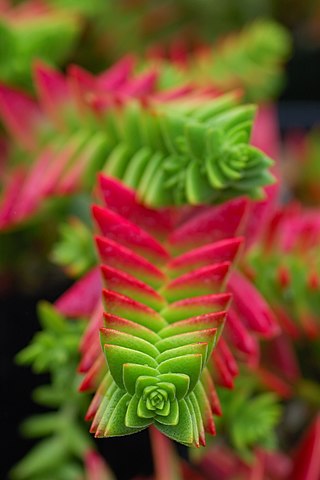
Crassula is a genus of succulent plants containing about 200 accepted species, including the popular jade plant. They are members of the stonecrop family (Crassulaceae) and are native to many parts of the globe, but cultivated varieties originate almost exclusively from species from the Eastern Cape of South Africa.

Myriophyllum aquaticum is a flowering plant, a vascular dicot, commonly called parrot's-feather and parrot feather watermilfoil.

Hydrocotyle ranunculoides, known commonly as floating pennywort, or floating marshpennywort, is an aquatic plant in the family Apiaceae. It is native to North and South America.

Ceratophyllum demersum, commonly known as hornwort, rigid hornwort, coontail, or coon's tail, is a species of flowering plant in the genus Ceratophyllum. It is a submerged, free-floating aquatic plant, with a cosmopolitan distribution, native to all continents except Antarctica. It is a harmful weed introduced in New Zealand. It is also a popular aquarium plant. Its genome has been sequenced to study angiosperm evolution.

Cabomba caroliniana, commonly known as Carolina fanwort and various other names, is an aquatic perennial herbaceous plant native to North and South America. Having been a popular aquarium plant, it has been exported around the world, and has become an invasive species in Europe and Australia.
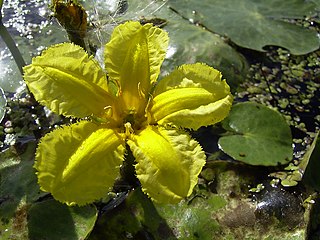
Nymphoides peltata is perennial, rooted aquatic plant with floating leaves of the family Menyanthaceae.

Hydrocotyle vulgaris, the marsh pennywort, common pennywort, water naval, money plant, lucky plant or copper coin, is a small creeping aquatic perennial plant native to North Africa, Europe, the Caucasus and parts of the Levant.

Crassula aquatica is a succulent plant known by the common names water pygmyweed, common pygmyweed and just pigmyweed. It is an annual plant of salt marshes, vernal pools, wetlands, and other fresh to brackish water bodies. It is at least partially aquatic, living in areas which are submersed much of the time. It also lives along muddy banks and in tidally-active areas of estuaries.

Crassula tillaea is a succulent plant known by its common names mossy stonecrop and moss pygmyweed. It is a small fleshy plant growing only a few centimeters in height. It is green when new and gradually turns orange and then deep red when mature. It has tiny triangular pointed leaves only a few millimeters long. A tiny flower or pair of flowers grows between each oppositely-arranged pair of leaves; the flowers are about two millimeters in length and width. The fruit is a minute follicle containing one or two seeds. This plant is native to Eurasia, particularly the Mediterranean Basin, but is known in other regions as an introduced species.
Crassula colorata, the dense pigmyweed or dense stonecrop, is an annual plant in the family Crassulaceae. The species is endemic to Australia, occurring in Western Australia, South Australia, New South Wales and Victoria.

In botany, succulent plants, also known as succulents, are plants with parts that are thickened, fleshy, and engorged, usually to retain water in arid climates or soil conditions. The word succulent comes from the Latin word sucus, meaning "juice" or "sap".

Myriophyllum verticillatum, the whorl-leaf watermilfoil or whorled water-milfoil, is a native to much of North America, North Africa, and Eurasia. It closely resembles another native milfoil, called northern water milfoil Whorled water milfoil is also easily confused with four types of invasive milfoils: Eurasian water milfoil, Variable water-milfoil, Parrot feather, and hybrid water milfoil.
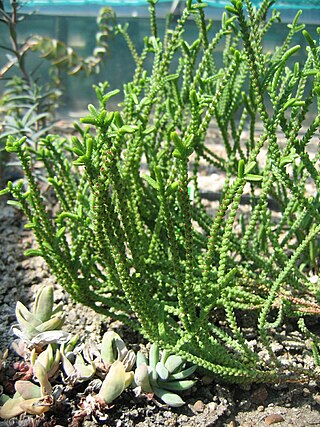
Crassula muscosa, synonyms Crassula lycopodioides and Crassula pseudolycopodioides, is a succulent plant native to South Africa and Namibia, belonging to the family of Crassulaceae and to the genus Crassula. It is a houseplant grown worldwide and commonly known as rattail crassula, watch chain, lizard's tail, zipper plant and princess pines.
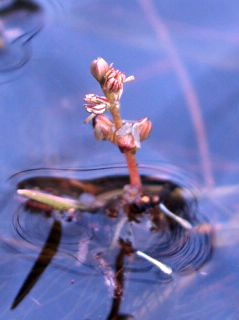
Myriophyllum alterniflorum, known as alternate water-milfoil or alternateflower watermilfoil, is a species of water-milfoil. It is native to Europe and Asia,has been introduced to North America and inhabits aquatic habitat, such as ponds and streams.

Crassula ovata, commonly known as jade plant, lucky plant, money plant or money tree, is a succulent plant with small pink or white flowers that is native to the KwaZulu-Natal and Eastern Cape provinces of South Africa, and Mozambique; it is common as a houseplant worldwide. Much of its popularity stems from the low levels of care needed; the jade plant requires little water and can survive in most indoor conditions. It is sometimes referred to as the money tree; however, Pachira aquatica also has this nickname.

Callitriche brutia, the pedunculate water-starwort, is a dwarf amphibious annual or perennial dicotyledon herb in the genus Callitriche. The common name of this species is water starwort. It colonizes aquatic environments, such as wetlands, lakes, rivers, streams, and pools, and it grows in oligotrophic conditions, meaning it grows in an environment that has little to sustain life. Pedunculate water-starwort was found in Ireland and England, but is now an invasive species due to its resistance to environmental stressors, and its ability to grow in still water.
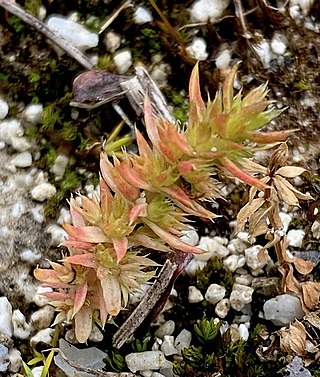
Crassula alata is a herb in the family Crassulaceae. It is native to the Mediterranean basin and is now also found in southern Australia and New Zealand. The succulent annual herb typically grows to a height of 5 centimetres (2.0 in). It produces white flowers in the spring time between August and October in the southern hemisphere.
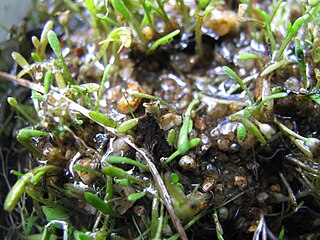
Glossostigma cleistanthum, also known as mudmat, is a freshwater aquatic plant native to Australia, New Zealand, India and East Africa. It is a cleistogamous plant, which is a type of self-pollinating plant that can propagate using non-opening flowers. Where growth is submerged, the leaves are between 0.5–2.5 inches long and bear closed, self-pollinating flowers. These leaves are nearly sessile and grow along the stem in alternating pairs that resemble rabbit ears. Where water recedes and growth is emergent, the leaves are much smaller, ranging between 0.2–0.5 inches in length. The emergent plants produce insect-pollinated flowers located on short stalks. It belongs to the family Phrymaceae which includes annuals and perennials.



















